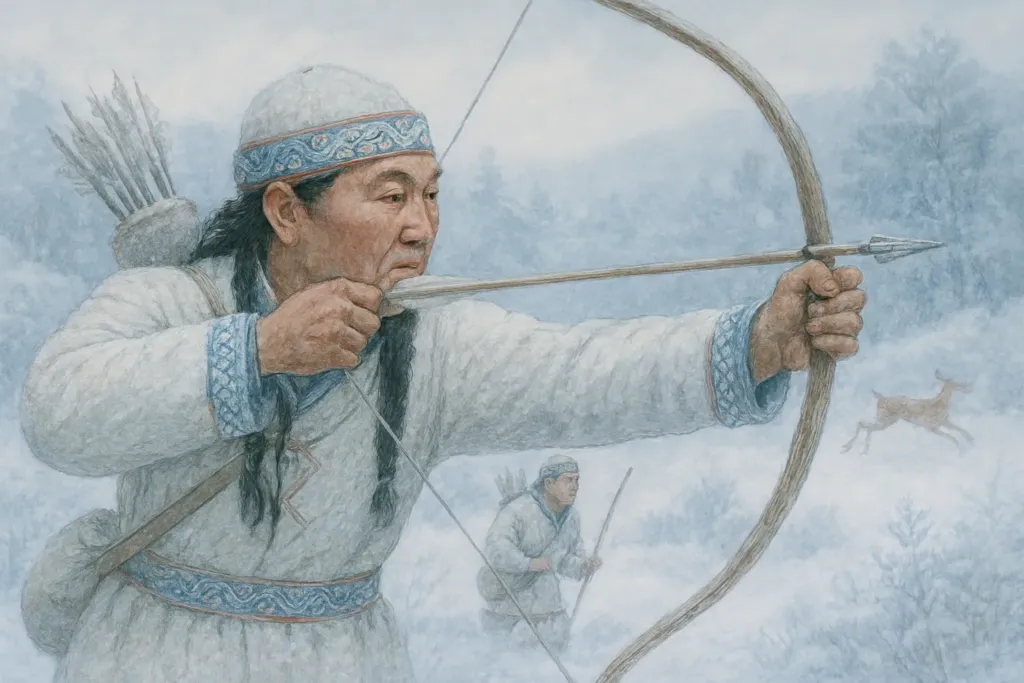The Nanai are an Indigenous people of the Amur basin in Russia and northeastern China. Their language is Nanai (Tungusic), with widespread bilingualism in Russian and Chinese. Worldview blends animism and shamanism with elements of Orthodoxy; water, fire, forest spirits, and ancestors are honored. Everyday norms value calm, thrift, and mutual aid; aggression is discouraged and disputes are mediated by elders. Attitudes toward alcohol are cautious; sobriety practices are encouraged, and drugs are rejected. Popular sports include wrestling, stick‑pull, archery, rowing races, and modern volleyball, soccer, and track.
History
Nanai ethnogenesis draws on Amur Neolithic cultures and later Tungusic‑Manchu migrations mixing with local populations. From the 17th century, they interacted with Russian explorers and Manchu officials through tribute and trade. In the 19th century, borders along the Amur and Ussuri split their range between Russia and China, bringing missions and market ties. The Soviet era brought sedentarization, schools, healthcare, collectivized livelihoods, and partial assimilation. Late‑20th‑century crises reduced traditional fishing; the 21st century has seen cultural revival, museums, ensembles, language support, and crafts.
Name origin
Self‑designations include Nanai, Nani, and Hedzeni; the older Russian exonym was “Golds.” In China they are known as Hezhe. Popular etymologies interpret the name as “people of the land,” while academic views link it to local Amur group self‑names.
Occupations
Traditionally: river fishing (salmon, sturgeon), hunting, gathering, river trade, dugout boat building, fish‑skin tanning, and birch‑bark crafts. Today: mixed livelihoods—traditional harvests plus roles in education, culture, tourism, public services, small business; cooperatives, cultural centers, souvenirs, and gastro‑tours are developing.
Physical description
Common traits include dark hair, brown eyes, complexions from light‑olive to tan, and medium‑to‑short stature adapted to river‑forest life. Racial typologies are outdated; internal phenotypic diversity is notable.
Habitat
Historical range: the Amur River and its tributaries, the Ussuri and Sungari. Today: Khabarovsk and Primorye krais, the Jewish Autonomous Oblast, Sakhalin, and Far Eastern cities in Russia; in China—Heilongjiang. Continent: Asia.
Wars and conflicts
Nanai did not wage expansionist wars; there were local disputes over fishing and hunting grounds and episodes of colonial‑era violence. Internal conflicts were settled by customary law and elder mediation. Contemporary tensions concern access to fisheries, ecology, and land rights, addressed by legal and negotiation channels.
Population
Pre‑revolutionary estimates ranged across the broader Amur area; Soviet counts recorded roughly 10–12 thousand. Around the turn of the 21st century Russia had about 11–12 thousand Nanai; by 2021 roughly 11.6 thousand, with about 5 thousand in China. Trends reflect 19th–20th‑century epidemics and assimilation, later growth through healthcare and education, and migration. Language shift has been significant, countered by education and media efforts.
Traditions, rituals, festivals
Ancestor veneration and fire‑ and water‑spirit rites are central, alongside life‑cycle ceremonies and cleansing rituals. Bear ceremonies and memorial feasts feature songs, dances, and processions. Modern festivals include Nanai Culture Days and youth sport‑folklore games (July–September), alongside regional and national holidays.
Myths and legends
Stories people the world with river, taiga, and hearth spirits; the shaman mediates realms. Epics feature culture heroes, totem animals (tiger, bear, fish), journeys of the soul, and origins of fire and crafts; women’s initiation tales and clan guardians hold a special place.
Notability
Nanai ornament and fish‑skin craftsmanship appear in museums across Russia and China; villages like Naikhin and Sikachi‑Alyan are known for cultural centers and Amur petroglyphs. Folklore ensembles and master artisans maintain carving, sewing, and song; Nanai culture figures in Far Eastern ethnographies and documentary film.
Food
Diet centers on fish (chum, pink salmon, salmon, sturgeon), roe, fish oil, berries, roots, and game. Dried and smoked fish, fish soups, offal dishes, and seasonal wild foods are common. Today, traditional preserves blend with contemporary recipes.
Clothing
Iconic garments are made from tanned fish skin—coats, robes, footwear—decorated with appliqué and embroidery. Winter wear uses furs (reindeer, sable, fox); summer outfits use woven fabrics; protective motifs carry clan and guardian meanings. Headdresses and belts incorporate beads, metal, and shells.
Tourism
Key stops include Nanai District (Khabarovsk Krai), ethnohouses and museums in Naikhin, fish‑skin workshops, and Sikachi‑Alyan’s petroglyphs and Amur shore routes. Community groups host visitors, offering craft workshops, culinary tastings, and festival trips. Infrastructure is modest; advance coordination is recommended.
Visitor etiquette
Ask before photographing or entering private yards; remove shoes indoors; don’t touch ritual items or drums. Respect fishing sites and quiet near the water; avoid offering alcohol; pay fair prices for crafts. Coordinate visits with local hosts, follow eco‑rules, and protect the Amur’s riverbanks.
- Tourist safety in Bukhara: how to spot and avoid crime
- Moscow
- 24 Facts About The Colosseum
- The Highest Settlements in the World: Life on the Roof of the Planet
- From trauma healers to in-house psychologists, hotels are increasingly catering to travellers’ mental health
- Sahalin
- The World’s Most Dangerous Countries for Tourism in 2025
- Bosphorus
- Borneo
- Island
- What to know when going to Brazil ?
- North Coast 500: a grand loop of Scotland’s Northern Highlands
- Indians
- Bali
- Sri-Lanka
- Kenya Nchi Yangu Song
- Namibia sees almost double-digit growth
- Kostroma (Russia)
- 9 Reasons Why People Love to Travel to Other Countries
- The World of Varans











